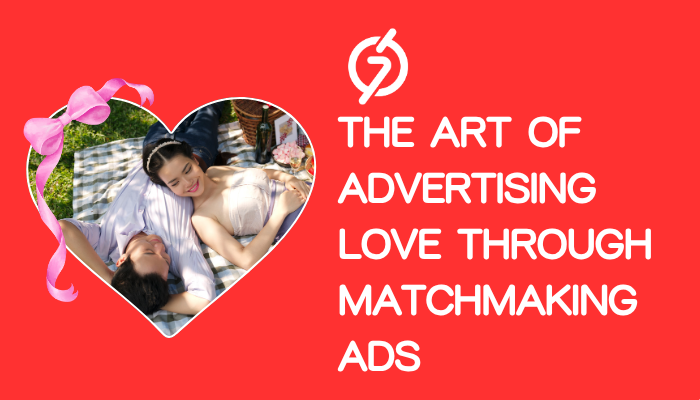In the ever-evolving landscape of digital marketing, Matchmaking Ads have emerged as one of the most intriguing and emotionally charged niches in advertising. Unlike traditional product promotions, these campaigns sell something far more intimate — the promise of connection. For advertisers, this space presents both immense opportunity and unique challenges. As the online dating industry expands into a multibillion-dollar ecosystem, the art of advertising love has never been more critical — or more competitive.
Where Emotion Meets Advertising Innovation
Did you know that the online dating industry is projected to surpass £9 billion globally by 2026? Behind that staggering figure lies a thriving market for matchmaking platforms and relationship-based services — all fuelled by effective advertising.
Advertisers no longer just sell subscriptions; they sell trust, compatibility, and the excitement of possibility. In a world where users swipe through countless profiles in seconds, attention is the most valuable currency. This makes Matchmaking Ads more than just a creative challenge — it’s a test of emotional intelligence, data precision, and authentic communication.
The Emotional Fine Line in Matchmaking Advertising
Here’s the tricky part. Advertising in the dating and matchmaking space isn’t like promoting a gadget or a fashion brand. You’re dealing with human emotions — love, loneliness, hope, and vulnerability.
Many advertisers face the same dilemma: how do you create an ad that converts without sounding manipulative or fake? Push too hard, and it feels inauthentic. Stay too subtle, and your message disappears in the noise.
Moreover, the landscape is flooded with platforms promising everything from long-term relationships to casual connections. This oversaturation means that advertisers must carve out a distinctive, trustworthy voice while complying with strict advertising guidelines, especially around language, imagery, and audience targeting.
It’s not enough to have a great offer — your ad must emotionally resonate while being strategically sharp.
What Smart Advertisers Are Doing Differently
Successful matchmaking advertisers have realised one critical truth: emotion alone doesn’t sell — context does.
A clever line like “Find your soulmate today” doesn’t mean much without a tailored delivery to the right audience segment. The top-performing campaigns blend behavioural insights with storytelling. They use user data ethically to craft messages that feel personal — not invasive.
For example, an ad that appears to a newly single user might focus on emotional recovery and confidence building, while one targeting professionals could highlight efficiency and compatibility through algorithms.
Visual storytelling also plays a huge role. Instead of idealised stock photos, real stories and relatable imagery outperform generic romance visuals. Authenticity has become the new persuasion.
To stay ahead, advertisers should use this Complete Checklist for Running Matchmaking Ads to evaluate campaign strategy, audience tone, creative delivery, and compliance before launching.
This approach ensures every ad is not only emotionally engaging but also performance-driven.
The Smarter Way to Craft Matchmaking Ads
Today’s best matchmaking campaigns are rooted in data-led creativity. Advertisers who merge the art of storytelling with the science of performance marketing are seeing significant ROI boosts.
Here are a few soft but powerful tactics gaining momentum in 2025:
Personalised Messaging:
Relevance is no longer optional in advertising — it’s expected. In matchmaking campaigns, personalisation is the key that unlocks emotional engagement. Advertisers are moving beyond generic taglines and experimenting with dynamic ad creatives that adapt to a user’s life stage, browsing habits, or emotional context. For instance, someone recently browsing self-improvement blogs might see an ad focused on “meeting like-minded people who share your growth mindset”, while another user exploring romantic films could be shown a message around “finding your perfect movie partner”.
Contextual triggers make all the difference. Time-sensitive offers during weekends, festive seasons, or even specific cultural events such as Valentine’s Day or Diwali can significantly increase click-through rates. The goal isn’t to interrupt — it’s to appear at the exact moment your audience is most open to connection.
Native Formats:
Gone are the days when banner ads alone could capture hearts or attention. The most effective matchmaking advertisers in 2025 are embracing native advertising, seamlessly integrating promotional content into editorial or lifestyle spaces.
Imagine reading an article about relationship communication or dating confidence, and coming across a natural placement promoting a trusted matchmaking platform. The tone fits, the context feels organic, and the reader doesn’t feel “sold to”. That’s the magic of native formats.
These ads deliver better engagement because they respect user experience. They blend into the content journey rather than disrupting it, leading to higher credibility and conversions. In fact, native matchmaking ads often outperform display banners by up to 60% in user engagement metrics, precisely because they tell a story rather than make a pitch.
Emotional Tone Matching:
Advertising love requires empathy. A single tone mismatch can make an ad feel awkward or insincere. That’s why emotional tone matching has become one of the most crucial soft skills for advertisers in the dating and matchmaking industry.
This technique involves aligning the creative tone, language, and imagery with the target audience’s emotional state and relationship goals. For instance, an ad aimed at individuals seeking long-term commitment should carry a warm, reassuring tone — calm colours, thoughtful copy, and imagery that evokes stability and companionship. Meanwhile, a campaign for casual dating might thrive with playful visuals, witty taglines, and a light-hearted vibe.
Advertisers who master tone matching create a seamless emotional connection between message and mindset. This doesn’t just improve conversion rates — it builds trust and long-term user loyalty, a rare feat in performance-driven industries.
Ethical Transparency:
In 2025, authenticity isn’t just a creative choice — it’s a competitive advantage. The dating and matchmaking space is built on human vulnerability, which means transparency must guide every part of the advertising process.
Consumers have grown increasingly sceptical of exaggerated promises, stock imagery, or clickbait messages that feel too polished to be true. Smart advertisers are responding with honesty and relatability. They’re replacing clichés with real testimonials, genuine success stories, and transparent pricing or process explanations.
Ethical transparency doesn’t just build credibility — it humanises your brand. When users sense honesty in your tone, they associate your service with safety and sincerity. In a world full of digital noise, that authenticity becomes your loudest selling point. Over time, this approach transforms customers into advocates who willingly share their positive experiences.
Platform Precision:
Choosing the right advertising platform is just as critical as crafting the message itself. What works on one medium may fall flat on another. The smartest advertisers today approach platform precision as both a science and an art.
For example, Google Search ads perform exceptionally well for intent-driven users actively looking for matchmaking services. Social media, on the other hand, is perfect for storytelling, brand awareness, and emotional connection through visual campaigns. Programmatic networks provide scale and automation, allowing brands to retarget users who’ve shown interest without being intrusive.
Advertisers should also consider user mood and behaviour patterns per platform. A person scrolling through Instagram during a lunch break engages differently from someone reading relationship advice on a blog at night. Matching your ad format and tone to that moment — whether it’s a carousel of success stories or a concise video testimonial — amplifies both relevance and performance.
The true power of platform precision lies in its ability to deliver the right message, at the right time, in the right space — ensuring no emotional or monetary effort goes to waste.
For businesses exploring this niche, it’s worth visiting Matchmaking ads resources that help advertisers design optimised campaigns within dating and relationship verticals.
Lessons from Real Campaigns
Across the industry, one trend stands out: intention-based segmentation. Not all matchmaking users are looking for the same outcome, so neither should your ads.
Campaigns that segment audiences by intent — such as “serious relationships”, “friendship-first”, or “casual dating” — outperform generic campaigns by over 40% on average. Advertisers who understand human psychology and communication nuance are leading the way.
Another insight: mobile-first storytelling. With over 75% of matchmaking traffic coming from smartphones, mobile-optimised creative is non-negotiable. Short, emotionally punchy visuals outperform long copy.
Equally important is trust-building. Transparent headlines, clear CTAs, and sensitivity in imagery are essential to maintain brand credibility. This is especially vital in cultures where online dating still carries social taboos.
Turning Insights into Action
So, what’s next for advertisers who want to excel in this growing vertical? It starts with action.
Before launching your next campaign, make sure you create an ad campaign that’s grounded in emotion, data, and authenticity. With the right combination of storytelling and targeting, even a simple ad can become a bridge between two people searching for connection.
Conclusion
At its heart, matchmaking advertising isn’t just about clicks or conversions. It’s about helping people find each other — and that’s a purpose-driven mission few industries can claim.
As advertisers, when we approach this category with empathy, creativity, and respect for human emotion, our campaigns become more than marketing tools. They become digital love stories — crafted carefully, delivered sincerely, and remembered fondly.
The art of advertising love lies in balance: between data and desire, storytelling and strategy, authenticity and aspiration. And when done right, Matchmaking Ads don’t just sell a service — they spark connections that might just change lives.
 :
https://www.pinterest.com/7search_ppc_ads/
:
https://www.pinterest.com/7search_ppc_ads/

